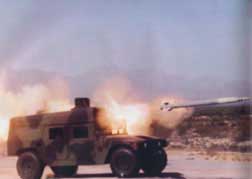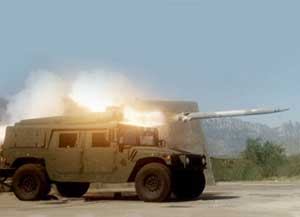 Line-of-Sight
Antitank (LOSAT) Weapon System consists of Kinetic Energy
Missiles (KEM) and a second-generation FLIR/video
acquisition sensor mounted on an air-mobile, heavy HMMWV
chassis. LOSAT is mounted on a modified HMMWV vehicle and
is accompanied by a wheeled re-supply vehicle. The system
is fully transportable by C-17, C-130, C-141 and C-5
aircraft, as well as the CH-47 helicopter and can be
sling-loaded under the UH-60L helicopter. Line-of-Sight
Antitank (LOSAT) Weapon System consists of Kinetic Energy
Missiles (KEM) and a second-generation FLIR/video
acquisition sensor mounted on an air-mobile, heavy HMMWV
chassis. LOSAT is mounted on a modified HMMWV vehicle and
is accompanied by a wheeled re-supply vehicle. The system
is fully transportable by C-17, C-130, C-141 and C-5
aircraft, as well as the CH-47 helicopter and can be
sling-loaded under the UH-60L helicopter.
The Line of Sight Antitank is a
dedicated antitank weapon system capable of providing a
high volume of accurate fires at ranges exceeding those of
current tank main guns. The LOSAT Weapon System consists
of an encased missile, missile shipping and storage
containers, Fire Unit, support structure, reload system,
Electro-Optical System (EOS), Target Acquisition System
(TAS), Fire Control System (FCS) and Pulsed Laser System (PLS).
The LOSAT will be mounted on an armament carrier, HMMWV
(M1113), will have a three man crew, and carry four ready
to fire Kinetic Energy Missiles (KEM). The KEM, a long rod
tungsten penetrator, accelerates up to 5000 feet per
second and has five times the kinetic energy of current
tank rounds. Time of flight to maximum range is less than
five seconds.
 The Fire Control system (FCS) allows the gunner to acquire and track up to two targets simultaneously and engage them in rapid sequential fires. Once the gunner issues launch consent, the system automatically guides the missiles to the target. The gunner is assisted by the FCS, which tracks the missile to the target. The LOSAT also features controls and displays along with digital telephone answering services communications compatible with the Force XXI Battle Command Brigade and Below (FBCB2) System. The LOSAT can operate autonomously or on conjunction with other systems through FBCB2 or FM communications. The Fire Control system (FCS) allows the gunner to acquire and track up to two targets simultaneously and engage them in rapid sequential fires. Once the gunner issues launch consent, the system automatically guides the missiles to the target. The gunner is assisted by the FCS, which tracks the missile to the target. The LOSAT also features controls and displays along with digital telephone answering services communications compatible with the Force XXI Battle Command Brigade and Below (FBCB2) System. The LOSAT can operate autonomously or on conjunction with other systems through FBCB2 or FM communications.
The LOSAT Weapon System provides the
gunner the capability to recognize a target beyond the
maximum effective range of the current TOW missiles, and
will incorporate the following capabilities:
embedded built in test/built in test equipment, automatic
boresight, self defense weapons, and room for growth.
The missile accelerates to 5000 feet per
second, flies to maximum range in less than four seconds
and delivers five times the kinetic energy of current tank
rounds. The fire control system allows the
gunner/commander to acquire and auto-track up to three
targets. Once a launch consent is issued, the system
automatically initializes and guides the missiles to the
targets in a sequential manner. Range of the LOSAT missile
is about 5 km.
The Kinetic Energy Missile weighs 174
pounds, is 113 inches long and 6.4 inches in diameter. The
current system provides for a three-man crew, but a crew
of two can also conduct engagements. With a missile speed
of 5,000 feet per second, it reaches maximum range in less
than five seconds. The LOSAT missile is a hit-to-kill
missile with no explosive warhead. It carries a long-rod
penetrator and destroys the target through the application
of brute force.
The key advantages of the LOSAT are the
tremendous overmatch lethality of the KEM, which defeats
all predicted future armored combat vehicles, and its
deployability. The system can be reloaded in less than 10
minutes using on board materiel handling equipment.
The KEM, which can travel up to about
5,000 feet per second, relies on its impact force -
rather than a warhead- to destroy its target. A
Forward-Looking Infrared acquisition sensor on the vehicle
is used to guide the KEM to the target. The system
utilizes a Heavy High Mobility Multipurpose Wheeled
Vehicle (HMMWV) heavy chassis, hypervelocity kinetic
energy missiles (KEM), a second generation forward-looking
infrared (FLIR/TV) acquisition sensor and has a crew of
two. The LOSAT system consists of a Humvee armed with four
ready-to-fire missiles, with eight missiles towed behind
in a resupply trailer. The LOSAT System carries four ready
missiles via two two-pack containers. LOSAT can operate
autonomously or with other systems using its digitized
Command and Control capability.
The LOSAT program started an Army ACAT I
system with oversight by DOT&E. In 1992, analysis by
the Army caused the program to be reduced to a Technology
Demonstration. The program was upgraded by the JROC to an
Advanced Concept Technology Demonstration (ACTD) (4QFY97).
Initially, LOSAT was to be mounted on an extended length
Bradley Fighting Vehicle. As a Technology Demonstration it
was to be mounted on an Armored Gun System (AGS) chassis
but when the AGS program was canceled, LOSAT was
reconfigured to a HMMWV chassis. Developmental testing has
been conducted using the fire control system to direct the
kinetic energy missile at tank targets.
Testing at White Sands Missile Range, NM
examined the launch effects of the LOSAT on an
expanded-capacity HMMWV. Under developmental test
conditions, the missile is capable of defeating any known
tank it hits. Test firing of the LOSAT missile in a
non-tactical configuration on top of a HMMWV has shown all
launch effects to fall within the Army's acceptable ranges
for human factor limits. Data gathered were extensive both
inside and outside of the vehicle. Measurements were made
of shock and g-load, on crash test dummies, and flash,
toxic gases, pressure, and sound in and outside the
vehicle. Numerous operational performance issues must be
addressed in future testing - either within the ACTD or
in subsequent formal OT&E covered by a TEMP.
In August 2002 Lockheed Martin received
a contract for the first production lot of tactical
Line-of-Sight Antitank (LOSAT) Weapon System missiles. The
$9.3 million contract represents the first production run
of the extremely powerful Kinetic Energy Missile (KEM),
which is fired from the LOSAT vehicle. Lockheed Martin
Missiles and Fire Control is the prime contractor on the
LOSAT program. The U.S. Army Aviation & Missile
Command, Huntsville, Ala., is the contracting agency.
Delivery of the missiles will be completed by July 2004.
These 108 missiles will be used to equip the first
tactical LOSAT unit, A Company of the 5-11th Parachute
Infantry Regiment.
|